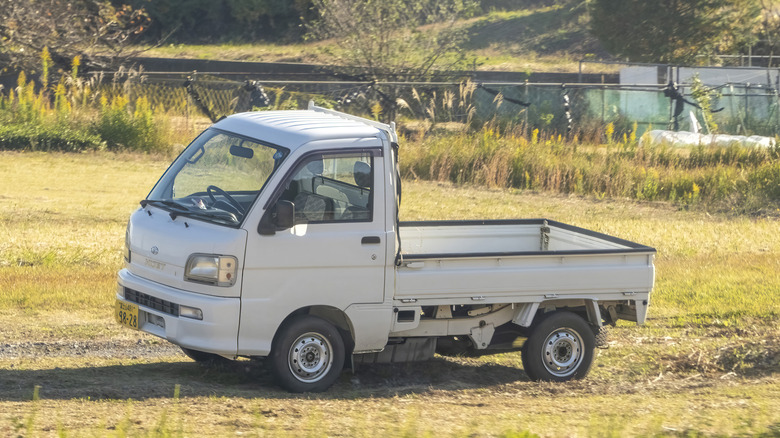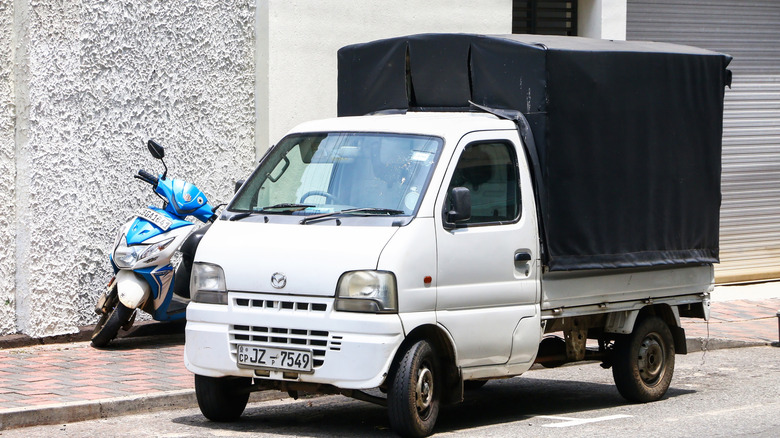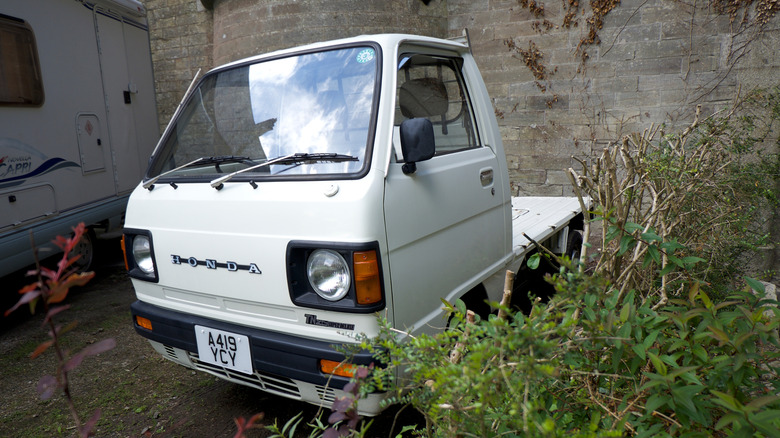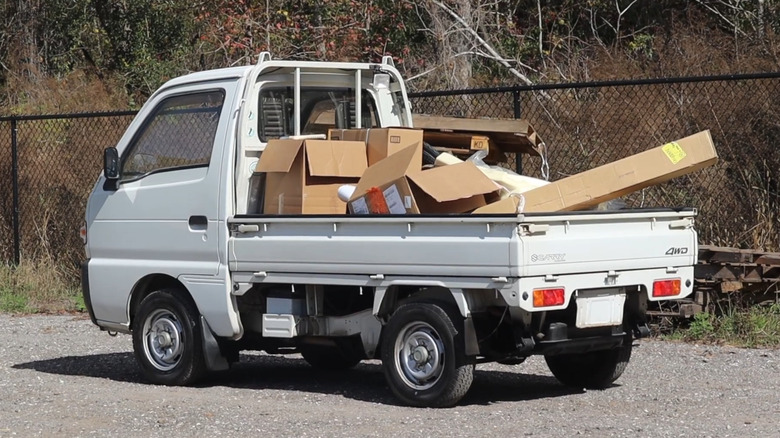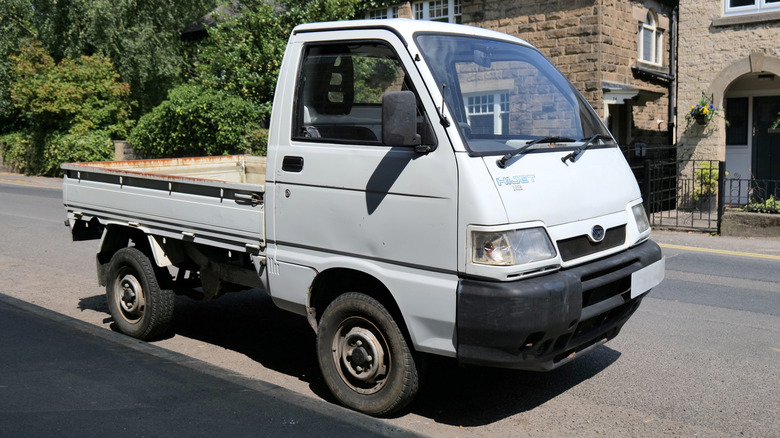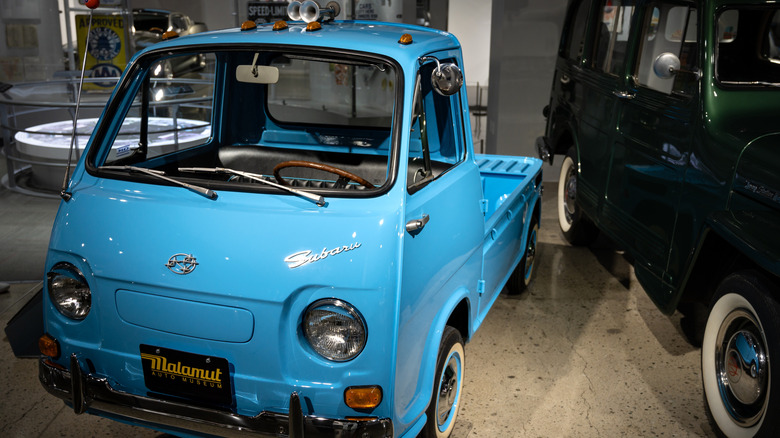5 Of The Fastest Japanese Kei Trucks, Ranked By Top Speed
Kei trucks are found all over Japan but these mini trucks are harder to come across overseas. First appearing in 1949, a compact truck is considered a kei truck if it's up to 11.2 feet long, 6.6 feet tall, has a load-carrying capacity under 771 pounds, and has an engine that only goes up to 660cc and 63 horsepower. But with these restraints, how fast can kei trucks really get?
To be completely honest, kei trucks are not made with speed in mind. Some mini truck owners have noted that they won't even go near a highway. One Reddit user even said: "The kei life is a laid-back one. If you give yourself enough time... You can get anywhere." To top it off, kei trucks are often limited to a top speed of 50 mph in some countries.
Even still, some drivers may be wondering if there are any that could potentially get on the highway without slowing down traffic. There are a few factors to consider — like if the truck is stock, if the AC is on, and if it has reduced weight due to lack of features — but there are some kei trucks that stand out as more capable at higher speeds.
Mazda Scrum - 49 mph
The Mazda Scrum — which has a pretty unfortunate name — came out in 1989 as a re-badged version of the Suzuki Carry. Because of this, it uses a Suzuki engine that produces 600cc and 45 hp. Because of kei truck guidelines, the Scrum is not too powerful, and its top speed is quite low as a result. Hills should also be avoided. As previously established, however, you probably are not buying a Mazda Scrum for its capabilities on the highway (in fact, the highways should even be avoided).
Instead, the Mazda Scrum makes for a great around-town truck that's super capable, especially with aftermarket options like a dump bed or plow. This is a great truck for clearing roads, moving around any debris — even big tree branches — that have gotten in the way, and getting around in snow. The Scrum also boasts 45 miles per gallon, which makes it quite fuel efficient — perfect for getting things done quickly and smoothly. While researching its many uses, however, try to avoid all the dirty words that pop up.
Honda Acty - 60 mph
The Honda Acty can barely reach minimum highway speeds but it has remained one of the most popular kei trucks in America due to its capabilities and affordability. Speed tests show the Honda Acty struggling to get up to 70 mph, especially when any slight elevation is involved. Owners often admit that the truck is not the best choice for long distance travel, especially since it can struggle to get up a hill. Being so light, going "high" speeds can also risk some swerving if there's any wind or bad weather.
But the Honda Acty shines when it's being driven around local roads. Reliable and useful, the Honda Acty is the perfect assistant when it comes to making deliveries around the city or agricultural help in the countryside. It can even be a great daily commuter, with some owners stating that the Honda Acty is perfectly fine cruising around 60 mph.
Suzuki Carry - 75 mph
The Suzuki Carry has been known to reach 75 mph. Honestly, that's probably quite comfortable for the Suzuki Carry, which only has the required 660cc. You won't be racing around the highway, but it has good acceleration and impressive handling due to its light weight so it makes for an enjoyable ride.
Still, the backroads may be better for its intended use of short deliveries around town — it wasn't really made with American highways in mind. As long as you don't need to reach fast speeds, the Suzuki Carry is a perfectly convenient kei truck for those that want to do some heavy lifting around a farm. When it comes to its bed space, the Suzuki Carry fits a lot and can even lower three sides of the bed to make it completely flat. This makes it capable of carrying even more than most kei trucks during each run — the new model boasts a max carry capacity of 2,072 including passengers.
Daihatsu Hi-Jet - 81 mph
This is another kei truck that came out in the 60s and stuck around due to its efficiency and zippiness. During its time on the road, however, it has gone through significant changes as the regulations around kei trucks shifted. It started with a two-stroke, 360cc engine and it's now racing around at 660cc. Other improvements include a hydraulic dump bed and power lift gates. But all of this wouldn't be too appealing if the Daihatsu Hi-Jet had issues getting around once it was loaded. Luckily its limited hp is enough to push its sub-2,000 pound body to over 80 miles per hour.
Of course, not every Daihatsu Hi-Jet is capable of reaching this top speed. Some tests have only reached the 70s. This could be due to the weight of whatever it's carrying, the terrain and elevation of the road, and if it's using stock tires and other components. Still, it's definitely one of the faster kei truck options out there. It's around the same speed as some of the fastest kei cars.
Subaru Sambar - 87 mph
The Sambar was first introduced in 1961 and has been around ever since, a favorite kei truck to have imported all over the world. The Sambar stands out amongst kei trucks when it comes to top speeds, which has made it pretty desirable in the states. The top speed is considered to be 87 miles per hour, although some owners report never getting close to that number. Still, this higher speed could be due to the Sambar's unique engine — unlike other kei trucks, the Sambar has a 4-cylinder engine. There's also a supercharged version, although it can be tougher to find.
The Subaru Sambar consistently hits higher speeds than other kei trucks due to its shorter stroke and higher rev speed. But some drivers have noticed that this also causes the truck to slow down quite a bit on inclines — this can be seen in a lot of test drives of the vehicle.
